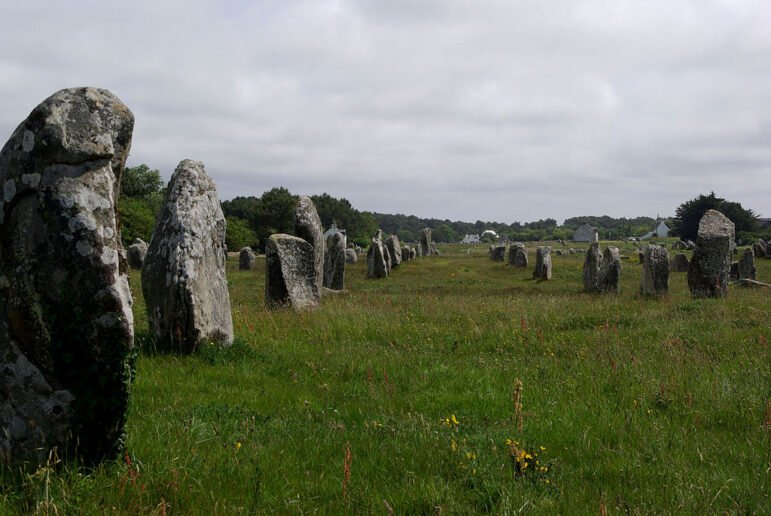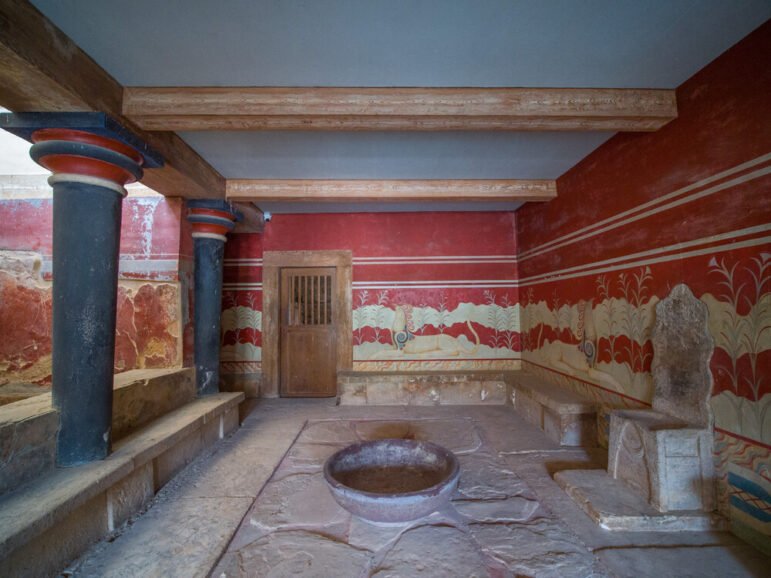Notice: Stefano Ciotti contributed to this text
PARIS – The United Nations Instructional, Scientific and Cultural Group (UNESCO) World Heritage Committee started assembly on July 6, 2025, and on July 11, after months of deliberation, finalized the addition of 26 new properties to its prestigious World Heritage listing. These additions deliver the overall variety of websites acknowledged for his or her “excellent common worth” to humanity to over 1,200, encompassing pure wonders, archaeological treasures, and cultural landscapes throughout the globe.
Among the many newly inscribed websites are areas that resonate with practitioners of Pagan spiritualities, historians of historical cultures, and advocates for Indigenous heritage. From the megaliths of Brittany to the fairy tombs of Sardinia, the 2025 additions spotlight humanity’s enduring relationship with the land, the lifeless, and the sacred.
Flag of the United Nations Instructional, Scientific and Cultural Group (UNESCO) [Public Domain
Domus de Janas: Sardinia’s Fairy Houses Unearthed
One of the most celebrated additions is Italy’s Domus de Janas, or “fairy houses,” a series of rock-cut tombs carved into Sardinian bedrock more than 5,000 years ago. Scattered across the island, approximately 3,500 of these pre-Nuragic structures form the largest and richest network of underground funerary architecture in the western Mediterranean.
According to Sardinian legend, the tombs were homes to the Janas, small fairylike beings. In reality, these hypogea served as burial chambers for early islanders between the 5th and 3rd millennium BCE. Each site reflects the spiritual beliefs, social hierarchies, and funerary customs of a community transitioning toward complex social organization.
Notable locations include Montessu, with 35 tombs arrayed like an amphitheater, and S’Incantu, near Alghero, whose multi-roomed painted tombs resemble Neolithic huts. The Sant’Andrea Priu necropolis impresses visitors with massive domus like the Tomb of the Chief, which spans 250 square meters. Sites such as Sas Concas and Anghelu Ruju offer additional insights, with symbolic engravings—including upside-down human forms—and even ancient stone tools left behind by the builders.

Domus de Janas de Monte Arista (necropolis) near Cardedu, Sardinia. Rock with several tombs. Photo Credit: Thiotrix CCA-SA 4.0]
Carnac Megaliths: France’s Neolithic Enigma Enshrined
In neighboring France, UNESCO has honored the Megaliths of Carnac and the Shores of Morbihan, an enormous serial property in Brittany. This space comprises the world’s most in depth assortment of Neolithic standing stones—over 3,000 in complete—organized in alignments, circles, dolmens, and burial mounds courting again to 4500–3300 BCE.
The primary alignments of Ménec, Kermario, Kerlescan, and Le Petit Ménec proceed to mystify archaeologists and religious seekers alike. Theories about their goal vary from astronomical observatories to non secular pilgrimage websites or ancestor monuments. Wealthy engravings and artifacts discovered within the space reveal a classy understanding of pure and religious environments, additional linking the stones to early ceremonial life alongside Europe’s Atlantic rim.
Breton folklore provides a legendary dimension: some locals declare the stones are petrified Roman troopers cursed by druids. Because of issues about degradation, customer entry is now largely restricted to guided excursions.

The well-known neolithic menhirs close to Carnac, Brittany, France [Karsten Wentink, Wikimedia Commons, CC 4.0]
Minoan Palatial Facilities: Crete’s Historic Hubs of Energy and Religion
Greece’s Minoan Palatial Centres have been additionally acknowledged as a serial website, comprising six archaeological complexes throughout Crete. These Bronze Age constructions (c. 1900–1100 BCE) replicate the peak of Minoan civilization—an early Mediterranean tradition identified for its maritime commerce, artistry, and matriarchal spiritual symbols.
Palaces reminiscent of Knossos, Phaistos, Malia, Zakros, and Kydonia weren’t merely royal residences however served as financial, religious, and political hubs. Elaborate frescoes, indoor plumbing, storage rooms, and central courtyards reveal a complicated society with a redistributive economic system and in depth spiritual rituals. Whereas these facilities lacked defensive partitions, their sudden collapse round 1450 BCE could have been because of pure disasters or Mycenaean conquest.

Knossos palatial centre. The Throne Room [Picture Credit score: Greek Ministry of Tradition – Courtesy
Murujuga Cultural Panorama
The Murujuga Cultural Panorama, situated in Western Australia’s Pilbara area, is dwelling to one of many largest and most vital collections of historical Indigenous rock artwork (petroglyphs) on this planet. The identify Murujuga comes from the language of the native Ngarluma folks and refers to what’s often known as the Burrup Peninsula.
The positioning comprises over a million rock engravings, a few of which date again greater than 40,000 years, making it an distinctive document of human creative and cultural expression. The art work consists of depictions of human figures, animals (like kangaroos, emus, and turtles), extinct species such because the thylacine (Tasmanian tiger), and summary geometric shapes.
Murujuga is just not solely a repository of visible heritage but additionally a sacred dwelling cultural panorama for the Conventional House owners, together with the Ngarluma, Yaburara, Mardudhunera, and Wong-Goo-Tt-Oo peoples. The petroglyphs replicate their religious beliefs, creation tales, and long-standing connection to the land.
Routes Throughout the Globe
UNESCO’s 2025 listing additionally emphasizes Indigenous and prehistoric heritage. Among the many most spiritually vital is Mexico’s Wixárika Route by means of Sacred Websites to Wirikuta, a pilgrimage path maintained by the Wixárika (Huichol) folks. Winding by means of the Sierra Madre Occidental to the Wirikuta desert, this route hyperlinks sacred mountains, springs, and temples in a dwelling custom that embodies Indigenous cosmology and identification.
In Russia, the Shulgan-Tash Cave—additionally known as Kapova Cave—was added for its Ice Age artwork: Paleolithic work of mammoths, horses, and symbols estimated to be 17,000 years outdated. The cave blends pure magnificence with religious imagery carved by prehistoric artists.
South Korea’s Petroglyphs alongside the Bangucheon Stream present animals, rituals, and day by day life from the Neolithic to early historic intervals, providing a window into Korea’s historical animistic beliefs.
The Faya Palaeolandscape within the UAE, in the meantime, preserves proof of early human migration out of Africa. Archaeological layers present steady occupation and motion courting again over 200,000 years.
Turkey’s Sardis and the Lydian Tumuli of Bin Tepe highlight the traditional Lydian capital and its monumental burial mounds—most famously, the tomb of King Alyattes. Town was as soon as a hub of early coinage and cultural fusion between Anatolia and the Hellenic world.
Different Websites Inscribed in 2025
The complete listing of newly designated World Heritage Websites spans continents and traditions, together with:
-
Cambodian Memorial Websites – Former Khmer Rouge detention and execution facilities
-
Xixia Imperial Tombs (China)
-
Palaces of King Ludwig II (Germany) – Together with Neuschwanstein and Linderhof
-
Maratha Army Forts (India)
-
Khorramabad Valley Prehistoric Websites (Iran)
-
Port Royal (Jamaica)
-
Mount Mulanje Cultural Panorama (Malawi)
-
Colonial Transisthmian Route (Panama)
-
Historic Khuttal Heritage Websites
-
Forest Analysis Institute Malaysia Forest Park Selangor
-
Peruaçu River Canyon (Brazil)
-
Møns Klint Chalk Cliffs (Denmark)
-
Bijagós Archipelago Ecosystems (Guinea-Bissau)
-
Gola Tiwai Complicated (Sierra Leone)
-
Mount Kumgang (Diamond Mountain) (North Korea)
By including these 26 websites, UNESCO continues its mission to guard essentially the most invaluable cultural and pure heritage throughout the globe. These sacred tombs, rock carvings, historical cities, and biodiverse landscapes should not solely important to understanding human historical past—additionally they function dwelling bridges between ancestral information and up to date identification whereas additionally celebrating the sacredness of the Earth and the reminiscence of the ancestors.




